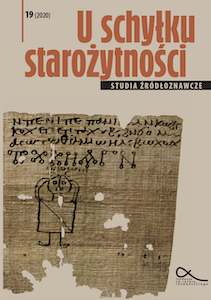The economy of Syrian monasteries (fifth–eighth century)
The economy of Syrian monasteries (fifth–eighth century)
Author(s): Ewa WipszyckaSubject(s): Christian Theology and Religion, History, Archaeology, History of Church(es), Economic history, Ancient World, Theology and Religion
Published by: Fundacja im. Rafała Taubenschlaga
Keywords: Greater Syria; hagiography; the histories of monasteries; monastic rules; cenobia; semianachoretic laurae; relationships of monastic communities with hierarchical church and laypeople; bishops;
Summary/Abstract: The economy of the monasteries of Greater Syria is not a subject of interest toresearchers of the three Churches of this vast area (pro-Chalcedonian, Monophysite, and Nestorian) for a very prosaic reason: few sources make it possible forus to research it. To make matters worse, the sources are dispersed both territoriallyand chronologically. Despite the flaws in the documentation I have gathered, thecomparison of information included in it gives us an image of the economy of various centres. Thanks to such case studies, divided by terrae incognitae, we drawcloser to the answers to primary questions: about the incomes of the monasteries,their expenses, and their cooperation with clerical hierarchy and secular elite, theauthorities of the Roman Empire, the Sasanian Empire, and the Arab Empire on aneconomic level. I paid particular attention to the involvement of (great and small)monasteries in land cultivation. The land offered to monasteries by monks joiningthem and by the representatives of the secular elite, as well as purchased land,underpinned the monastic economy. I also compiled data indicating that, contraryto popular belief, the monks of Greater Syria worked in the fields and workshops,helped erect buildings, and assisted in producing wine and olive oil.
Journal: U schyłku starożytności - Studia źródłoznawcze
- Issue Year: 2020
- Issue No: XIX
- Page Range: 179-259
- Page Count: 82
- Language: English

